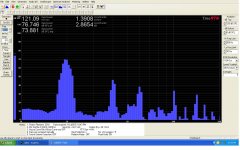Forget about infinite baffle and sealed box, they do not have enough SPL at 16 Hz. You must use vented box tuned to 16 Hz. Mount the vented box over the hole in the ceiling.But I've discovered that there is a pretty spacious area above the ceiling of the speaker and the pipe chambers. This is space between the ceiling and the roof of the building. We could cut a 2 x 3 foot hole in the ceiling and install a couple of Infinite Baffle drivers there.
Some over at the organ forum are concerned about cone excursion on the bass speakers. They make the case that a large sealed box has a smoother frequency response curve.
Sealed box indeed has a smoother response, but you need high SPL at 16 Hz, which only a vented box can deliver.
The existing Bourdon is just loud enough for the existing organ. It was placed right in front of the shades to get more of the sound out into the Sanctuary. It is the only 16 foot stop in the pedals.
On the new configuration, we'll replace these pipes with a digital 16 foot version. We're also adding a 16 foot Diapason. The pedal division will also have a tab labeled "Pedal Alterable". My thinking is that this tab will initially be assigned to a 16 foot Fagatto. But it can also be assigned to other ranks. This is where can assign the 32 foot Diapason when it is needed. We'll also have a 32 foot Contra Violon, a 16 foot Principal and a 16 foot Lieblich Gedeck to choose from.
So you are thinking of creating some digital reeds and strings, Nice. How about an 8 foot and a 16 foot french trumpet? At some spit and fire!
Have you had the opportunity to try out both subwoofers at the same time?
And what are the room dimensions you are testing in and how close to the walls are you?
Helps me to figure out what some of the higher frequency noise is in your measurement graphs.
I ran some more measurements tonight. I was careful to make sure the mike signal was not too hot. These are TrueRTA, not REW.
16 Hz, mike 4 feet away.
View attachment 493020
There's still a lot of distortion showing up in that response curve. Look at the peak at 48 Hz - it's as high as, if not higher than, the one at 16 Hz.
When you're doing these tests, try switching TrueRTA to Oscilloscope mode, and then adjust the V/div and ms/Div settings until you have at least one full waveform on screen. If the top of the waveform appears to be flattened out, then something along the signal chain is being overloaded.
Do you have any of the other speakers on when you're performing these tests?
For comparison purposes, here's the response of my POC3 to a 40 Hz signal. Notice the significant difference between the fundamental and the overtones @ 80 Hz and 120 Hz? Given the size and Xmax of the HT18 driver, you should be achieving very similar results with your build at 16 Hz.
Brian, thanks for the input. I did notice those - though I admit to being a novice at determining what everything I see means.
I did not have any other speaker running. There are a few objects in the room that did vibrate from time-to-time. It isn't a very large room.
I mentioned before that I can hear a small leak at the joint. I also think I'm hearing some very slight vibration in the smaller upper section of the box, right above the joint between the two sections.
I've tried to examine the situation carefully. Here's what I THINK. The box was made in two sections to allow us to get it through the door and tilt it into an upright position even with the relatively low ceiling in the speaker chamber. The plan was - and still is - to place the upper section on the lower sections after it is in place. Then a liberal application of PL Construction Adhesive was going to be used to seal and hold the two sections together solidly. Right now, for testing, I'm only using a removable caulking material for that joint.
But that joint seems to be at a weak area of the upright boards of both sections of the box. I think I need to add some internal bracing in the lower section just below that joint. This will add structural integrity at the end of the longest boards adjacent to the joint.
Too, I think I need to add internal braces to the lower part of the upper section. This might reduce the chances that those boards are vibrating at the joint.
I also believe one of the side walls in the upper section (the one on the front face) may be right at an eighth of an inch shorter than the boards of the other two walls. This - coincidentally - is where I seem to be hearing the very slight leak. So the boards aren't meeting their designated partner in the other section evenly. I think I need to use an electric planer to get all three of these boards in the upper section as even as I can. Even PL Construction Adhesive has some give - by design, Without the upright walls of the top and bottom sections of the box butting evenly against one another, there's a risk of movement - thus vibration at that weak point.
I suspect that MIGHT BE what is causing some of those extra sounds you're seeing in the measurement.
I may also need to redesign the joint so I have some boards with screws to more firmly hold all these boards firmly together.
I'd already said I needed to work on that joint. If my analysis is anywhere close to correct, your input about what you see in the measurement may serve to confirm that. The Devil is always in the picky details.
@#$ - And I was hoping I was out of the speaker box making business for a little while!!! 😡
Bach On
Last edited:
@ Bach On
What you may be seeing as higher frequency peaks in your RTA graphs is reflections.
It is a very common thing in measuring loudspeakers inside. And one of the reasons why you may have read about ground plane and anechoic measurements. They are two types of measurements that have no reflections to muddy the response your microphone picks up.
Next question.
Do you have any interest in doing an impedance curve on your cabinet?
Your friendly REW (#*^@$#""+) Can do the impedance graph with the correct setup.
From an impedance graph we can tell you very quickly what is going on internally, if for instance you might need a stiffener, or if you have a serious leak.
Many nuggets of information can come from a combination of a swept frequency response and an impedance graph.
Tis how I can do consulting without ever seeing some of the products I work on.
What you may be seeing as higher frequency peaks in your RTA graphs is reflections.
It is a very common thing in measuring loudspeakers inside. And one of the reasons why you may have read about ground plane and anechoic measurements. They are two types of measurements that have no reflections to muddy the response your microphone picks up.
Next question.
Do you have any interest in doing an impedance curve on your cabinet?
Your friendly REW (#*^@$#""+) Can do the impedance graph with the correct setup.
From an impedance graph we can tell you very quickly what is going on internally, if for instance you might need a stiffener, or if you have a serious leak.
Many nuggets of information can come from a combination of a swept frequency response and an impedance graph.
Tis how I can do consulting without ever seeing some of the products I work on.
Yes, you need frequency sweeps (say, 10-200) and distortion stats. REW puts them on a single, lovely chart, like the one I posted #681 which shows distortion at all frequencies in the sweep. Neat. Done. In the case of sweeping past 16 Hz, you'll see how much 2nd harmonic, third, etc.
There are many question to be raised about your RTAs, as Brian Steele has clearly outlined. Youy've taken a single frequency, say 16 Hz, and shown what comes out of the speaker. Quite clear although only for that single input.
Your measurement system may have unknown gremlins, but it seems to be producing meaningful results. For 16 Hz, you've demonstrated that the individuals distortion tones (at 32, 48....) are vastly more hearable than the 16 Hz note which you want to sing forth. On organ music, not as horrible as that may sound in theory although there may be better ways to make a system which realistically starts at a more down-to-earth expectations of 32 Hz.
1. You'd really like make sure you know what input is going into the speaker.
2. You really want to eyeball sweeps, esp if twinned with distortion, as I posted.
3. Now turning to Mark's ever-cogent observations, how to FIX. In addition to his thoughts, I'd check for vibrating panels because that's where harmonic distortion often hides. Talk to somebody with good intuition about bracing. It is anathema on this forum to mention steel (like an L-beam or T-beam) sure will make a panel stiff. A long threaded "jiffy rod" from side to the other is really simple and good and needs nothing but a 3/8 inch hole and some big washers.
Ben
This post is free of sim comments
There are many question to be raised about your RTAs, as Brian Steele has clearly outlined. Youy've taken a single frequency, say 16 Hz, and shown what comes out of the speaker. Quite clear although only for that single input.
Your measurement system may have unknown gremlins, but it seems to be producing meaningful results. For 16 Hz, you've demonstrated that the individuals distortion tones (at 32, 48....) are vastly more hearable than the 16 Hz note which you want to sing forth. On organ music, not as horrible as that may sound in theory although there may be better ways to make a system which realistically starts at a more down-to-earth expectations of 32 Hz.
1. You'd really like make sure you know what input is going into the speaker.
2. You really want to eyeball sweeps, esp if twinned with distortion, as I posted.
3. Now turning to Mark's ever-cogent observations, how to FIX. In addition to his thoughts, I'd check for vibrating panels because that's where harmonic distortion often hides. Talk to somebody with good intuition about bracing. It is anathema on this forum to mention steel (like an L-beam or T-beam) sure will make a panel stiff. A long threaded "jiffy rod" from side to the other is really simple and good and needs nothing but a 3/8 inch hole and some big washers.
Ben
This post is free of sim comments
Last edited:
How about a board and two opposed shims with some PL in all the mating surfaces. Couple taps with a marteau and you iz braced.
No need to go off and get all complicated like.
If you have a table saw I can send you a picture of a very simple shim maker.
I've made hundreds, literally over the years. All from scrap wood.
No need to go off and get all complicated like.
If you have a table saw I can send you a picture of a very simple shim maker.
I've made hundreds, literally over the years. All from scrap wood.
Let me see....
Do I want to have a Root Canal done, or do I want to tackle REW?
Hmmm. That's a Hard decision. 🙄
Obviously, I'd like to make the ^#$$# program work!!! But I'm also obviously doing something wrong. I can get it to send sweeps to the speakers. BUT the measurements I take all tell me my input level is too low.
I've been to this screen. But it seems to be making the assumption I'm using the internal sound card of my laptop instead of the ART Dual Pre USB input.
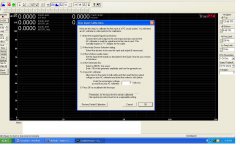
TrueRTA reads everything from the mike just fine. So what suggestions do you have to get the mike volume up to a level that makes REW happy?
Bach On
P.S. TrueRTA has this very quick sweep. I ran it last night.

I see nothing in TrueRTA towards obtaining impedance measurements.
Here's the attempt I made with REW on the triangular cabinet.
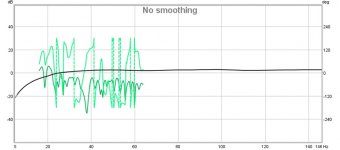
Do I want to have a Root Canal done, or do I want to tackle REW?
Hmmm. That's a Hard decision. 🙄
Obviously, I'd like to make the ^#$$# program work!!! But I'm also obviously doing something wrong. I can get it to send sweeps to the speakers. BUT the measurements I take all tell me my input level is too low.
I've been to this screen. But it seems to be making the assumption I'm using the internal sound card of my laptop instead of the ART Dual Pre USB input.

TrueRTA reads everything from the mike just fine. So what suggestions do you have to get the mike volume up to a level that makes REW happy?
Bach On
P.S. TrueRTA has this very quick sweep. I ran it last night.

I see nothing in TrueRTA towards obtaining impedance measurements.
Here's the attempt I made with REW on the triangular cabinet.

Last edited:
But it seems to be making the assumption I'm using the internal sound card of my laptop instead of the ART Dual Pre USB input.
I think I covered that problem a few posts back.
It is indeed the source of most of the REW angst.
You have to choose your ART DualPre as the default soundcard.
USB OPERATION:
Connect your analog jacks and external power supply first. If you are using one of the analog outputs
for local low latency monitoring, connect that to your monitor system or headphones. Next, set the
front panel controls for proper operation as per the previous sections. Then connect the USB cable to
the appropriate input on your computer and lastly to the USB connector on the USB Dual Pre.
Once the USB connection is made and your computer is on, the USB interface circuitry will be powered
by your computer over the USB bus and the unit will automatically connect and try to set your
computer “Default Audio Device” to be “USB Audio CODEC”. Usually the computer will do this automatically
whenever a USB device is first connected, but it is sometimes necessary to make the
selection manually.
The same settings may need to be made in your particular audio application as
well (Check your application instructions).
These settings should be made while the two units are
connected and powered on. Select one of the following sound recording (input) settings:
WINDOWS 98SE: Settings => Control Panel => Multimedia
Choose the preferred device: “USB Audio Device”
WINDOWS XP: Settings => Control Panel => Sounds and Audio Devices => Audio.
Choose the mixer device: “USB Audio CODEC”
or Programs =>Accessories =>Entertainment =>Volume Control=> Options=> Properties
Choose the mixer device: “USB Audio CODEC”.
WINDOWS VIsta: Settings => Control Panel => Sound => Playback Tab and Record Tab.
Choose: “USB Audio CODEC”
Mac OS9.1+: Control Panels => Sound.
Choose: “USB Audio CODEC”
Mac OS10+: System Preferences => Sound.
Choose: “USB Audio CODEC”
Your computer audio output “Speaker” is now set to be the “USB Audio CODEC” and playback audio
is routed to the USB Dual Pre. This must be done while the USB Dual Pre is connected to the
computer and powered on. After the above settings are made, your computer will automatically
reconfigure itself back to these settings every time the USB Dual Pre is reconnected to the computer.
At this point your recording software will select and control which channels are being recorded and
which channels are being monitored. There are many computer recording software packages available
today that allow for multi-track recording. If you are using multiple units and connecting more than
one over the USB bus, they will appear as “USB Audio CODEC 1”, “USB Audio CODEC 2”, etc. in
your recording application. Please refer to your recording software documentation for the best way to
assign channels and set recording and monitoring parameters.
You have proved that it works using TrueRTA.
REW needs a little push.
REW needs a little push.
Based on my success with the program so far, my candid assessment is that what it needs requires vigorous strong movement of a leg and a boot to match. 😡
The equipment is at the church. I've got to go over there tonight and tidy up so the housekeeping police don't get too snippy. I'll tinker with it some more.
😀
BO
Now turning to Mark's ever-cogent observations, how to FIX. In addition to his thoughts, I'd check for vibrating panels because that's where harmonic distortion often hides. Talk to somebody with good intuition about bracing. It is anathema on this forum to mention steel (like an L-beam or T-beam) sure will make a panel stiff. A long threaded "jiffy rod" from side to the other is really simple and good and needs nothing but a 3/8 inch hole and some big washers.
Ben
This post is free of sim comments
Yes. I can just hear the vibrations - especially on that front face with the leak - especially at lower pitches. And I'm convinced it is partly because of that joint.
I'm leaning towards this as a solution for the internal bracing. I have both 2x4s and 2x2s that could be used. None of the panels are parallel to each other, so at least one of the brace ends must be miter cut. I have a chop saw that will do that. Then I can use wood glue and screws to secure the braces tight. Each panel would get a brace - and the largest hypotenuse panel would get two. Wood glue has very little give, but it can be brittle. The screws can be inserted from the outside for extra strength. Silicone caulk can then be used to seal any tiny gaps that might result.
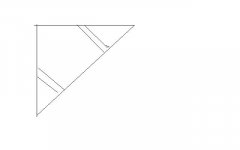
I'm going to try again on REW. But it doesn't seem to like the setup on my Windows XP machine. But I've got a lot of stuff on my plate right now. I may not have sufficient time for many long sessions troubleshooting REW. I may have to do triage.
Bach On
I've come to believe SIMS can be a very useful tool. I don't think they were intended to be a weapon. I'm fine with people stating what they believe with confidence. I'm less comfortable with putting down the beliefs of others.
Last edited:
I've come to believe SIMS can be a very useful tool. I don't think they were intended to be a weapon. I'm fine with people stating what they believe with confidence. I'm less comfortable with putting down the beliefs of others.
If you get to do an actual as built impedance response you will be a little more interested in how close a simulation can get to the real deal.
It can be very educational.
.. like the one I posted #681 which shows distortion at all frequencies in the sweep. Neat. Done. In the case of sweeping past 16 Hz, you'll see how much 2nd harmonic, third, etc.
#886. sorry.
B.
Lots of progress. Should be clear at this point that designing, building, and testing are an iterative process.
Freq sweep looking like what is expected. The RTA plots are providing about 15 readings per octave which, I suppose, resembles 1/12 smoothing in REW.
"Impedance" tells the speaker nerd something about the motion of the cone. Sure, I'd like to see it. But at this point, characterizing the output in the pews is the criterion.
However, you do need to satisfy yourself that the input to the speaker is reasonably flat and without much distortion. Nobody can predict for sure what the bass roll-off might be, although I doubt it is much to fuss about.
Smoothing matters. With lots of smoothing, your curves will come out beautifully flat because you've averaged all the peaks and dips across an octave. But without much smoothing, you'll be looking at every tiny glitch the mic picks up.
Earlier I mentioned that REW needs to be quit and then restarted after you've selected the external mic, on a Mac.
Chop saw. Easier to get L-beam steel bars from Home Depot and screw to the outside of longest unsupported panels, space permitting?
Great progress. The end is near.
Ben
Freq sweep looking like what is expected. The RTA plots are providing about 15 readings per octave which, I suppose, resembles 1/12 smoothing in REW.
"Impedance" tells the speaker nerd something about the motion of the cone. Sure, I'd like to see it. But at this point, characterizing the output in the pews is the criterion.
However, you do need to satisfy yourself that the input to the speaker is reasonably flat and without much distortion. Nobody can predict for sure what the bass roll-off might be, although I doubt it is much to fuss about.
Smoothing matters. With lots of smoothing, your curves will come out beautifully flat because you've averaged all the peaks and dips across an octave. But without much smoothing, you'll be looking at every tiny glitch the mic picks up.
Earlier I mentioned that REW needs to be quit and then restarted after you've selected the external mic, on a Mac.
Chop saw. Easier to get L-beam steel bars from Home Depot and screw to the outside of longest unsupported panels, space permitting?
Great progress. The end is near.
Ben
OK. I tinkered and putzed around with REW tonight. I've been through the Windows XP Control Panel and every part connected to the selection of a Sound Card. I do have USB Sound Card Selected. And I am getting a signal from the ART Dual Pre.
I did some more measurements tonight.
Some seem to have worked. Others still warn of death and probable dismemberment because the input level was low.
First, I tried a set of automated sweeps from 16 up to 96 Hertz with Impedance selected. REW didn't like that. I got a warning message, but it did produce a graph. I have no idea at all what it is telling me.
Here's SPL and Impedance

Here's a measurement of distortion on a 16-64 Hz, sweep
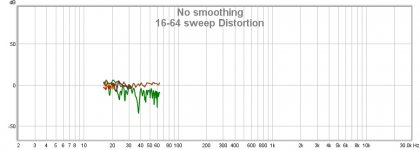
I switched over to TrueRTA and did a measurement of a sinewave at 16 Hz. I lowered the Amplitude from 20 to 10. Mike 3 feet in front of speaker cone. I also dialed back the gain on the ART Dual Pre. Got this:
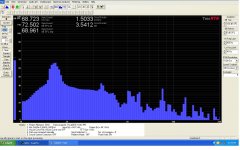
And 32 Hz
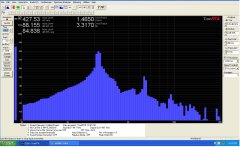
The overtones and partials are down some. But the SPL is not all that loud at the lower frequencies.
I'm tired. Going to bed.
Bach On
I did some more measurements tonight.
Some seem to have worked. Others still warn of death and probable dismemberment because the input level was low.
First, I tried a set of automated sweeps from 16 up to 96 Hertz with Impedance selected. REW didn't like that. I got a warning message, but it did produce a graph. I have no idea at all what it is telling me.
Here's SPL and Impedance

Here's a measurement of distortion on a 16-64 Hz, sweep

I switched over to TrueRTA and did a measurement of a sinewave at 16 Hz. I lowered the Amplitude from 20 to 10. Mike 3 feet in front of speaker cone. I also dialed back the gain on the ART Dual Pre. Got this:

And 32 Hz

The overtones and partials are down some. But the SPL is not all that loud at the lower frequencies.
I'm tired. Going to bed.
Bach On
Attachments
Getting closer. A lot less distortion showing up on RTA, down to about 10%. What's different?
Your second upload is the money shot. It shows freq response and, I assume, total harmonic distortion. Great. But run 10 or 15 to 200 Hz, if you can (takes a just a few seconds more).
But the REW display can be greatly improved (and without re-running anything). You can set the bars 10 dB apart (instead of your current 50 dB apart.... too coarse to read). There are little "+" and "-" pictographs in the upper left corner of the chart (small, might not be visible till you scan over them). Click the "+" once or twice.
There's also a means of adjusting the averaging to get 1/12. The control outside the chart in furthest right side lets you do that. Again, no need to re-run curve.
Ben
Your second upload is the money shot. It shows freq response and, I assume, total harmonic distortion. Great. But run 10 or 15 to 200 Hz, if you can (takes a just a few seconds more).
But the REW display can be greatly improved (and without re-running anything). You can set the bars 10 dB apart (instead of your current 50 dB apart.... too coarse to read). There are little "+" and "-" pictographs in the upper left corner of the chart (small, might not be visible till you scan over them). Click the "+" once or twice.
There's also a means of adjusting the averaging to get 1/12. The control outside the chart in furthest right side lets you do that. Again, no need to re-run curve.
Ben
Last edited:
16 hz for church organ
FWIW, I've never seen or heard of a classical (for lack of a better term) organ that had an intentional vibrato for pitches that low, and I've seen and heard quite a few.
BTW, I second your motion for more civility.
Keys
On the bandwidth issue, I think it's important to note that the pipes, the wind that drives them, and all the environmental factors probably do add up to low notes that don't perfectly track a single fundamental frequency, but rather wag around a little bit, especially if they're played with vibrato.
We can't live in the theory world when we're talking about a physical instrument that most likely refuses to comply at every available opportunity.
FWIW, I've never seen or heard of a classical (for lack of a better term) organ that had an intentional vibrato for pitches that low, and I've seen and heard quite a few.
BTW, I second your motion for more civility.
Keys
Getting closer. A lot less distortion showing up on RTA, down to about 10%. What's different?
Your second upload is the money shot. It shows freq response and, I assume, total harmonic distortion. Great. But run 10 or 15 to 200 Hz, if you can (takes a just a few seconds more).
But the REW display can be greatly improved (and without re-running anything). You can set the bars 10 dB apart (instead of your current 50 dB apart.... too coarse to read). There are little "+" and "-" pictographs in the upper left corner of the chart (small, might not be visible till you scan over them). Click the "+" once or twice.
There's also a means of adjusting the averaging to get 1/12. The control outside the chart in furthest right side lets you do that. Again, no need to re-run curve.
Ben
What is different is the amplitude of the sine wave being sent. The earlier graphs used 20 in the program. I set it to 3 for these. I'm assuming that may be in decibels.
What is apparent to me is that the distortion and vibrations are worse when the volume to the box is higher. If some of those extra sounds are reflections in the Sunday School room as Mark suggested, the reflections are probably more plentiful with the volume turned up.
The measurement I did last week on that lowest Bourdon pipe Low C was around 90 dB. That is at a nominal 32 Hz.,
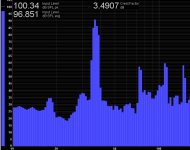
What I see from this box is now producing around 78 dB at the same pitch.
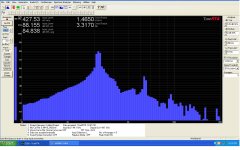
If I turn up the gain on the amp up to get the same kind of SPL on the driver as the pipe, the distortion and vibrations seem to grow worse.
I do, of course, remember that another cabinet will also be playing these same pitches. I'm eager to hear the two boxes combined. That will begin to give me an idea what people will hear in the pews.
I might get the hang of REW if I tinker with it a couple more decades.
Bach On
Last edited:
What is apparent to me is that the distortion and vibrations are worse when the volume to the box is higher. If some of those extra sounds are reflections in the Sunday School room
The measurement I did last week on that lowest Bourdon pipe Low C was around 90 dB. That is at a nominal 32 Hz.,
The RTA display gives useful information and might be all you need to debug the design. But your second chart doesn't look right with smearing of the tones.
I'd say "..reflections" might change the loudness of some of the harmonics accidentally, but not create the sound that shows up as distortion in your recording. Like to hear from others on that. Road, rail, and airplane noise, often barely hearable by humans, will introduce erroneous readings. Also subways and streetcars, if that's a big problem there.
On most music, harmonics (esp even numbered ones) aren't as noxious as you'd think looking at the chart*. And on organ music, possibly the odd-numbered ones too.
Is that a Boudon pipe, speaker, or speakers?
Ben
*but distortion and harmonics will damage stereo imaging with a sub except in some set-ups.
Last edited:
- Status
- Not open for further replies.
- Home
- Loudspeakers
- Subwoofers
- 16Hz for church organ
